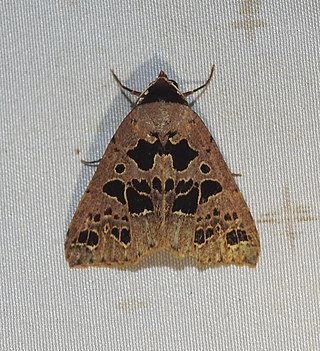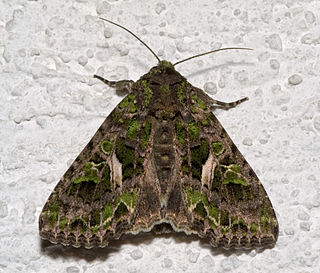Metachanda is the sole genus in tribe Metachandini of moth subfamily Oecophorinae. Metachandini was originally described as family Metachandidae by Edward Meyrick in 1911, and at the time also contained the genus Chanystis, which is currently unplaced to tribe within Oecophorinae. It has also previously been described as tribe Metachandini of subfamily Gelechiinae.
Agathiphaga is a genus of moths, known as kauri moths. and is the only living genus in the family Agathiphagidae. This caddisfly-like lineage of primitive moths was first reported by Lionel Jack Dumbleton in 1952, as a new genus of Micropterigidae.
Heliosia is a genus of moths in the family Erebidae erected by George Hampson in 1900.
Anereuthina is a genus of moths in the family Erebidae.

Anoba is a genus of moths of the family Erebidae. The genus was previously classified in the subfamily Calpinae of the family Noctuidae, but now is classified as part of the subfamily Anobinae, of which Anoba is the type genus.
Epitausa is a genus of moths in the family Erebidae. The genus was erected by Francis Walker in 1857.

Trachea is a genus of moths of the family Noctuidae erected by Ferdinand Ochsenheimer in 1816.
Celonoptera is a monotypic moth genus in the family Geometridae. Its only species, Celonoptera mirificaria, is found in south-eastern Europe. Both the genus and species were first described by Julius Lederer in 1862.
Heliosia alba is a moth of the family Erebidae. It was described by George Hampson in 1914. It is found in Taiwan.
Heliosia aurantia is a moth of the family Erebidae. It was described by Rothschild in 1912. It is found in New Guinea.
Heliosia charopa is a moth of the family Erebidae. It was described by Alfred Jefferis Turner in 1904. It is found in Australia, where it has been recorded from Queensland.
Heliosia crocopera is a moth of the family Erebidae. It was described by George Hampson in 1900. It is found on New Guinea.
Neoscaptia eurochrysa is a moth of the subfamily Arctiinae. It was described by George Hampson in 1914. It is found on New Guinea.
Heliosia jucunda is a moth of the family Erebidae. It was described by Francis Walker in 1854. It is found in the Australian states of Queensland and New South Wales.
Heliosia micra is a moth of the family Erebidae. It was described by George Hampson in 1903. It is found in Australia.
Heliosia monosticta is a moth of the family Erebidae. It was described by George Hampson in 1900. It is found on Borneo. The habitat consists of lowland forests, dry heath forests and coastal scrubs.
Heliosia perichares is a moth of the family Erebidae. It was described by Alfred Jefferis Turner in 1944. It is found in Australia, where it has been recorded from Queensland and New South Wales.
Heliosia punctinigra is a moth of the family Erebidae. It was described by Rudolf van Eecke in 1920. It is found on Java in Indonesia.
Heliosia rufa is a moth of the family Erebidae. It was described by John Henry Leech in 1890. It is found in the Russian Far East (Primorye) and China.
Heliosia suffusus is a moth of the family Erebidae. It was described by Rothschild in 1913. It is found in New Guinea.

